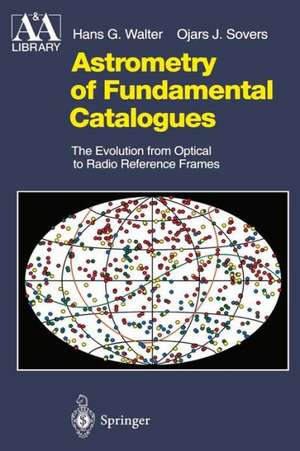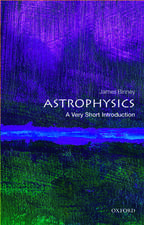Astrometry of Fundamental Catalogues: The Evolution from Optical to Radio Reference Frames: Astronomy and Astrophysics Library
Autor Hans G. Walter, Ojars J. Soversen Limba Engleză Paperback – 29 oct 2012
| Toate formatele și edițiile | Preț | Express |
|---|---|---|
| Paperback (1) | 638.24 lei 6-8 săpt. | |
| Springer Berlin, Heidelberg – 29 oct 2012 | 638.24 lei 6-8 săpt. | |
| Hardback (1) | 641.20 lei 6-8 săpt. | |
| Springer Berlin, Heidelberg – 26 iul 2000 | 641.20 lei 6-8 săpt. |
Din seria Astronomy and Astrophysics Library
- 17%
 Preț: 496.37 lei
Preț: 496.37 lei - 15%
 Preț: 603.58 lei
Preț: 603.58 lei - 19%
 Preț: 455.24 lei
Preț: 455.24 lei - 17%
 Preț: 525.72 lei
Preț: 525.72 lei - 13%
 Preț: 393.37 lei
Preț: 393.37 lei - 19%
 Preț: 524.14 lei
Preț: 524.14 lei - 17%
 Preț: 393.90 lei
Preț: 393.90 lei - 15%
 Preț: 647.40 lei
Preț: 647.40 lei - 15%
 Preț: 541.54 lei
Preț: 541.54 lei - 17%
 Preț: 362.70 lei
Preț: 362.70 lei - 18%
 Preț: 1006.55 lei
Preț: 1006.55 lei - 18%
 Preț: 745.33 lei
Preț: 745.33 lei - 15%
 Preț: 641.20 lei
Preț: 641.20 lei -
 Preț: 397.38 lei
Preț: 397.38 lei - 15%
 Preț: 598.21 lei
Preț: 598.21 lei - 15%
 Preț: 658.05 lei
Preț: 658.05 lei - 23%
 Preț: 815.07 lei
Preț: 815.07 lei -
 Preț: 409.89 lei
Preț: 409.89 lei - 15%
 Preț: 610.61 lei
Preț: 610.61 lei -
 Preț: 393.90 lei
Preț: 393.90 lei - 15%
 Preț: 655.27 lei
Preț: 655.27 lei - 18%
 Preț: 951.47 lei
Preț: 951.47 lei - 18%
 Preț: 960.42 lei
Preț: 960.42 lei - 18%
 Preț: 1397.68 lei
Preț: 1397.68 lei - 18%
 Preț: 959.98 lei
Preț: 959.98 lei - 18%
 Preț: 1012.08 lei
Preț: 1012.08 lei - 15%
 Preț: 481.03 lei
Preț: 481.03 lei - 15%
 Preț: 672.43 lei
Preț: 672.43 lei -
 Preț: 413.15 lei
Preț: 413.15 lei - 18%
 Preț: 1554.72 lei
Preț: 1554.72 lei - 18%
 Preț: 1410.63 lei
Preț: 1410.63 lei -
 Preț: 390.08 lei
Preț: 390.08 lei - 18%
 Preț: 944.99 lei
Preț: 944.99 lei - 19%
 Preț: 502.94 lei
Preț: 502.94 lei - 15%
 Preț: 654.12 lei
Preț: 654.12 lei - 24%
 Preț: 851.62 lei
Preț: 851.62 lei - 19%
 Preț: 515.32 lei
Preț: 515.32 lei - 15%
 Preț: 663.14 lei
Preț: 663.14 lei - 15%
 Preț: 656.43 lei
Preț: 656.43 lei - 18%
 Preț: 741.68 lei
Preț: 741.68 lei - 15%
 Preț: 647.40 lei
Preț: 647.40 lei -
 Preț: 388.90 lei
Preț: 388.90 lei - 18%
 Preț: 1217.72 lei
Preț: 1217.72 lei - 15%
 Preț: 651.51 lei
Preț: 651.51 lei - 15%
 Preț: 655.27 lei
Preț: 655.27 lei -
 Preț: 347.59 lei
Preț: 347.59 lei - 18%
 Preț: 794.39 lei
Preț: 794.39 lei
Preț: 638.24 lei
Preț vechi: 750.88 lei
-15% Nou
Puncte Express: 957
Preț estimativ în valută:
122.12€ • 127.87$ • 101.30£
122.12€ • 127.87$ • 101.30£
Carte tipărită la comandă
Livrare economică 09-23 aprilie
Preluare comenzi: 021 569.72.76
Specificații
ISBN-13: 9783642631580
ISBN-10: 3642631584
Pagini: 252
Ilustrații: XIV, 233 p.
Dimensiuni: 155 x 235 x 13 mm
Greutate: 0.36 kg
Ediția:Softcover reprint of the original 1st ed. 2000
Editura: Springer Berlin, Heidelberg
Colecția Springer
Seria Astronomy and Astrophysics Library
Locul publicării:Berlin, Heidelberg, Germany
ISBN-10: 3642631584
Pagini: 252
Ilustrații: XIV, 233 p.
Dimensiuni: 155 x 235 x 13 mm
Greutate: 0.36 kg
Ediția:Softcover reprint of the original 1st ed. 2000
Editura: Springer Berlin, Heidelberg
Colecția Springer
Seria Astronomy and Astrophysics Library
Locul publicării:Berlin, Heidelberg, Germany
Public țintă
ResearchCuprins
1. Fundamental Catalogues.- 1.1 Introductory Remarks.- 1.2 Objectives of Fundamental Catalogues.- 1.3 Background of Conventional Fundamental Catalogues.- 1.4 Inertial Reference Systems and Frames.- 1.5 Precession and Nutation.- 1.6 Determination of the Luni-solar Precession.- 1.7 Conventional Stellar Celestial Reference Systems.- 1.8 Conventional Extragalactic Celestial Reference Systems.- 2. The Conventional Fundamental Catalogue FK5.- 2.1 Historical Review.- 2.2 The FK5 Celestial Reference System.- 2.3 First Principles of Compiling the FK5.- 2.4 Scope of the FK5 Work.- 2.5 Transition to the Standard Epoch J2000.0.- 2.6 Organization of the FK5.- 3. Contributions of Space Astrometry to Fundamental Catalogues.- 3.1 Astrometric Space Missions.- 3.2 The Astrometry Satellite Hipparcos.- 3.3 Observing Principle.- 3.4 Organization of the Data Reduction.- 3.5 From Photons to Grid Coordinates.- 3.6 Reduction to Reference Great Circles.- 3.7 Sphere Solution.- 3.8 Construction of the Hipparcos Catalogue.- 4. Astrometry with Radio Interferometers.- 4.1 Radio Astronomy.- 4.2 Techniques of Radio Interferometry.- 4.3 The Observables.- 4.4 Requirements for Astrometry.- 5. Fundamental Catalogues of Extragalactic Radio Sources.- 5.1 System Definition.- 5.2 Some Specific Features of the ICRS Definition.- 5.3 The Extragalactic System Versus the FK5 System.- 5.4 Building Blocks for Catalogue Establishment.- 5.5 Methods of Fundamental Catalogue Construction.- 6. The International Celestial Reference Frame: ICRF.- 6.1 The Principles of ICRF Construction.- 6.2 Appraisal of the Origins, Context, and Role of the ICRF.- 6.3 Accuracy Assessment of the ICRF.- 6.4 Future Maintenance of the ICRF.- 7. Hipparcos Catalogue Tie with Conventional Celestial Reference Frames.- 7.1 Link with the Extragalactic Reference Frame.- 7.2 Link with the FK5 Reference Frame.- 7.3 Testing the Rigidity of the FK5 Frame.- 7.4 Refinement of the Hipparcos Link with the Extragalactic Reference Frame.- 8. Future Prospects.- 8.1 Interdependence of Astrometry and Fundamental Catalogues.- 8.2 Prospective Observational Techniques.- 8.3 Prospects for the Celestial Reference Frame.- Epilogue.- References.
Recenzii
"Such a book was desired since long time and the present compact and, on the other side, very detailed and competent description, analysis and explanation of the basic part of astrometry fills a gap in the scientific literature and fulfils the needs of a variety of disciplines from geodesy up to fundamental physics. [...] One of the many advantages of this book is the fact that it is readable for and well understood by nonexperts in the field." (Journal of Geodesy, 2001)
"The time is propitious for this scholarly book. You can find in it the details of how this leap forward in positional astronomy was achieved and marvel at it." (The Observatory, 2001)
"I can only cite what Viktor Abalakin says in the Prologue: The book, revealing the fundamentals and principles of the art of Fundamental Catalogue construction on the basis of processing optical observations of stars and radio measurements of extragalactic sources, is a timely manual of long-lasting value for everybody who is practically engaged in the field of Astrometry." (Astronomische Nachrichten, 2002)
"The most attractive aspect of Walter and Sober’s book is the attempt of erecting a bridge between the traditional optical astrometry and the newborn radio astrometry. The book is addressed mainly to the Astrometric public in general. It is composed of two complementary parts dedicated to a detailed description of both observation methods, and the techniques employed in the compilation of the so-called fundamental reference systems [...] For an Astrometry expert, the book could be separated in two volumes, his attention being raised by the complementary part. The actual unified release, however, has certainly a place in any Astronomy bookshelf, even in an amateur’s one, as a rich reference source on all questions concerning reference frames and systems." (Celestial Mechanics and Dynamical Astrometry, 2003)
"The time is propitious for this scholarly book. You can find in it the details of how this leap forward in positional astronomy was achieved and marvel at it." (The Observatory, 2001)
"I can only cite what Viktor Abalakin says in the Prologue: The book, revealing the fundamentals and principles of the art of Fundamental Catalogue construction on the basis of processing optical observations of stars and radio measurements of extragalactic sources, is a timely manual of long-lasting value for everybody who is practically engaged in the field of Astrometry." (Astronomische Nachrichten, 2002)
"The most attractive aspect of Walter and Sober’s book is the attempt of erecting a bridge between the traditional optical astrometry and the newborn radio astrometry. The book is addressed mainly to the Astrometric public in general. It is composed of two complementary parts dedicated to a detailed description of both observation methods, and the techniques employed in the compilation of the so-called fundamental reference systems [...] For an Astrometry expert, the book could be separated in two volumes, his attention being raised by the complementary part. The actual unified release, however, has certainly a place in any Astronomy bookshelf, even in an amateur’s one, as a rich reference source on all questions concerning reference frames and systems." (Celestial Mechanics and Dynamical Astrometry, 2003)
Textul de pe ultima copertă
Celestial fundamental catalogues are a prerequisite for the determination of absolute positions and motions in space. Presently, positional astrometry is at the watershed between classical fundamental catalogues, based on moving reference stars, and modern catalogues, based on extragalactic reference objects with non-measurable motion. This book addresses the concepts and methods of the respective construction techniques leading to the stellar frame of the FK5 (Fifth Fundamental Catalogue) and to the newly adopted extragalactic radio reference frame, ICRF (International Celestial Reference Frame), with its extension to optical wavelengths by the Hipparcos Catalogue. While principal outlines of meridian circle observations are given, emphasis is put in some detail on the VLBI technique as applied to astrometry, and to the observational techniques used in the Hipparcos mission, including the tie of the originally non-anchored rigid Hipparcos sphere into the ICRF.
Caracteristici
Due to powerful computers and the internet there is a change of paradigm taking place in astrometry The authors, collaborators in the Hipparcos mission, present a final and definitive description of the concept of fundamental catalogues which will serve as a basis for future constructs












